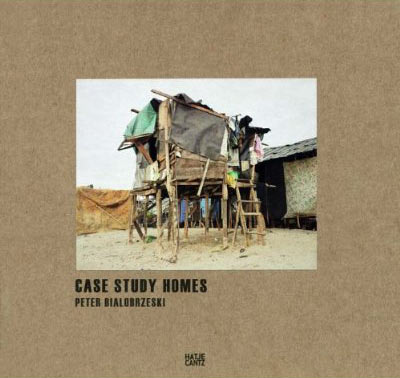Review: Case Study Homes by Peter Bialobrzeski

Described as “one of the most significant movements in post-World War II architecture” (source), the Case Study House Program “included the building and design of 36 experimental modern prototypes single-family homes in Southern California.” The Program’s announcement stated that it was “important that the best material available be used in the best possible way in order to arrive at a ‘good’ solution of each problem, which in the over-all program will be general enough to be of practical assistance to the average American in search of a home in which he can afford to live.” (source) Case Study House No. 22, “L.A.’s original dream home”, was made famous by photographer Julius Shulman. The houses in Peter Bialobrzeski’s Case Study Homes are also “good solutions”, affordable to live in, but they lack the cool and glamour of Case Study House No. 22. They are ramshackle contraptions, erected in a place called Baseco, a squatter camp near Manila, home to maybe 70,000 people. Nobody knows, there is nobody to count them. It is hard to say whether these houses are dream homes for their occupants - I’m tempted to think they are not.
A typology of sorts, Case Study Homes is intended to serve as more than a visual study of huts made from whatever might be available. In his introduction to the work, the photographer talks about who is living in the Basecon slum (migrant workers from the Philippine countryside), and he talks about images produced by FSA photographers in the 1930s.
Such is the power of photography: It conjures up other images, it allows the making of connections, it asks questions, it will bring about interpretations. I can think of countless ways to tie these photos in with issues, historical and contemporary. Case Study Homes is one of those cases where this is better left to the viewers.
Peter Bialobrzeski is well known for a certain photographic style (large-format work, usually taken at dusk or dawn), but Case Study Homes deviates from it - the photography is done as matter-of-factly as possible. It would be a grave error to mistaken this with assuming the photographer’s detachment from these houses. Talking of how people in his Hamburg neighbourhood “take a rather folkloric approach to the third world” (let’s not kid ourselves that this phenomenon is limited to that particular neighbourhood in that particular Western city!), Bialobrzeski writes that “these images remind me of something completely un-hip: the long-forgotten word ‘humility.’”
Humility. Maybe we can bring some of it back, and Case Study Homes might just serve very well as a starting point.
Case Study Homes, photographs by Peter Bialobrzeski, 84 pages, Hatje Cantz